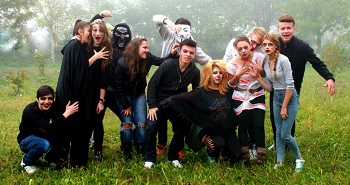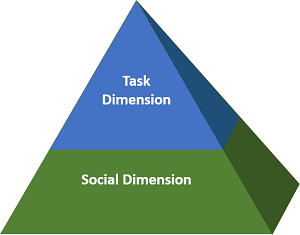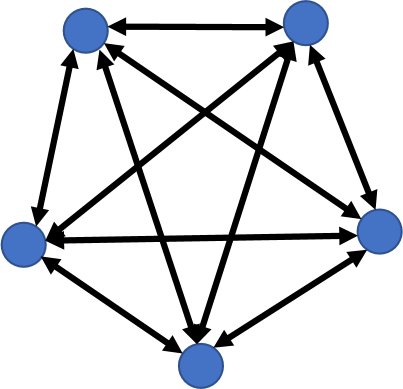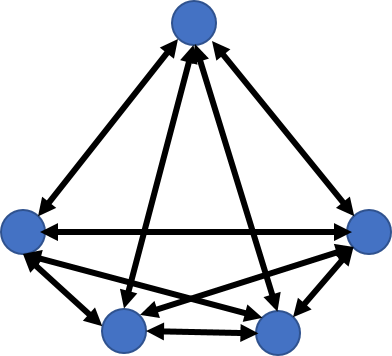|
Module VII: Small Group Communication
Section 1: Elements of a Group
After completing this section, students should be able to:
- illuminate the differences between social and task dimensions of a group.
- describe how roles are taken on through emergence and the method of residues.
- classify task and social maintenance needs and the roles which emerge to fulfill them.
- recognize negative group roles.
- distinguish laissz-faire, democratic, and autocratic leadership.
- discriminate between the positive and negative aspects of having a strong, central group leader.
Human beings are very social creatures. We have a strong, driving need to connect with others. We need interactions and relationships to give us a sense of belongingness and acceptance. Without human contact, we begin to lose a sense of self and a sense of value. We seek out others, form relationships with them, and use those individuals as ways of fulfilling our interpersonal needs. In the process of forming these connections, we also form groups. The various types of groups and what happens within a group setting will be discussed.
Social Groups versus Task Groups |
 |
| Image 1 |
Humans join two types of groups; social and task. Social groups are those gathered for enjoyment and pleasure. While task groups can certainly be enjoyable, and while social groups can complete a task, they are several marked differences:
Membership Method: For a task group, a noticeable process exists in which we move from not being a member to being a member. We may be elected, appointed, hired, volunteer, or so on to move from outside the group to inside the group. Social groups, however, do not have such an overt membership method. With social groups, it is a fairly random process of connecting with people, testing for common interests, and tacitly agreeing to join together.
Duration: Task groups typically have a defined duration, such as when the task is finished, the end of the year, or the end of terms in office. Even if a task group is long lasting, when the membership changes, the dynamics of the group start over. As we change members, we change the personality of the group. For social groups, there is no defined ending point. Social groups may fade due to changing interests, people moving, or other such external events, but there is no sense of “we’ll be a social group until X.”
Meta-communication: Meta-communication refers to talking openly about communication dynamics. For task groups, meta-communicationMeta-communication is possible due to our use of langauge to create mental images of the world. For more, see Module IV, Section 1 is a necessary conversation in order to discuss how the work is going to be done, how decisions are going to be made, and what expectations group members have for each other. For social groups, we rarely engage in such meta-communication, except when we are departing a gathering: we may say, “I really enjoyed talking to you.” Just imagine a person, in the middle of a conversation, saying, “We’re having a good talk now, aren’t we?” Chances are this sort of meta-communication would virtually end the conversation.
Fulfillment of Interpersonal Needs: While task groups function best when members feel a sense of acceptance and belongingness, fulfilling those intepersonal needsFor more on these basic needs, go to Module I, Section 1 is secondary to getting the work done. If you are in a task group, you still have to get the work done even if you do not feel a strong sense of acceptance. With social groups, however, if we do not feel acceptance and belongingness, we do not gather with them. The whole purpose of social groups is to satisfy those interpersonal needs.
 |
| Image 2 |
Task/Social Balance: Task groups also engage in social interaction in order to develop the social dimension. Ultimately, the group must focus on the task; the task dimension takes priority over the social dimension. With a social group attempting to complete a task, the task may take a back seat to social interaction. For example, for 20 years a group of Keith's friends have met monthly or so to eat and play Pictionary, yet sometimes they get to talking and never quite get around to playing the game. Even though their “task” is to play Pictionary, the social aspect of their gathering is more important.
To understand group dynamics, we must first accept a fundamental premise: we are people first, and we are workers second. To manage how a group works, we must consider a group as an interpersonal relationship among several people. A common mistake in attempting to get a group to function better is to squash any sort of personal interaction, such as stories, jokes, and side comments, and enforce a rigid, stick-to-the-agenda approach. This "agenda-whipping" approach dehumanizes the group, making working on the task something to get finished versus something to excel at.
While the group may finish the work more quickly, the quality of the work will be minimal at best. They will engage in pseudowork, which is superficial, low quality work. They will be on task and will quickly reach agreement on decisions, but the decisions will have little thought behind them. Minimal discussion, virtually no disagreement, and very little consideration of options and other ideas will take place. While members may appear to be working well as a group, in reality they are just going through the motions to get the job completed.
 |
| Image 3 |
The social dimension refers to the quality of relationships among group members. The task dimension refers to the work done to acheive the goal of the group. As reflected in image 3, the social dimension is the foundation of the group, forming a solid base for quality task work. If the social dimension is absent or weak, the task work is undermined, creating an environment ripe for pseudowork.
The relationships in the social dimension do not have to be close friends, intimates, or other such connections. Collegial relationships fostering respect, trust, comfortableness, and openness can serve as a solid foundation for quality group work.
When we first join a task group, we may be a bit uncertain: awkward, out-of-place, self-conscious, and typically guarded in what we say. If we do not know the other group members, we cannot predict how they will act, or how they will respond to us. As we begin to get to know the personalities of the members, we gain the ability to anticipate how they will behave, and typically the awkwardness and discomfort begins to fade. Our uncertainty is dropping, and our predictability is growing.
The process of lowering uncertainty also describes the development of trust, a key factor in the social dimension. Trust is the belief another person will be ethical, truthful, and dependable. So when we say, “I trust my partner,” we mean “I can predict my partner will not do anything, at least deliberately, to cause me physical or emotional harm.” So as trust grows in a group, we relax and are willing to open up far more as we gain confidence we will not be rejected, insulted, or disrespected.
Trust leads to several important interaction behaviors:
- More openness. Group members are more willing to speak up and offer ideas and opinions. The substance groups work with are ideas and suggestions, so as members engage more openly, the group has a richer body of material to work with.
- More risk-taking. Members become more willing to share what may seem like silly or off-the-wall ideas. Since the fear of rejection is lowered, they are more willing to risk throwing out these ideas. Often these more radical, unique suggestions can lead to very creative decisions. Typically, within every “stupid” idea is the seed of a good idea.
- More social tangents. While this may seem counterintuitive, it is very important task groups engage in some social conversations, such as jokes, stories, and sharing personal information. We get to know each other more deeply and genuinely through social interaction than through task interactions, which builds more trust. The group must not let the social tangents take over the group, but with a good balance of social and task work, the group can develop a very healthy personality.
- More comfort/Less anxious to leave. As we get more comfortable with the members, we are less driven to get finished just for the sake of escaping the situation. Contrast this with early in the life of the group when our uncertainty is high and the desire to escape is likewise strong, clearly not a good recipe for quality group work. As our comfort level increases, the urge to flee diminishes and we spend more time on task or building the relationships in the social dimension. The more we enjoy being with the group, the more we are willing to spend time on the task.
Just like any relationship, the social dimension is not something we can force to develop; however, we can create conditions favorable for its growth.
Since the core of the social dimension is trust, and trust develops from knowing about each other, the social dimension develops using reciprocal self-disclosureThis is the same reciprocal self-disclosure used to create interpersonal relationships. See Module V, Section 2.. Self-disclosure is simply sharing new information about ourselves. We start with superficial items, like our name, and then slowly move into more personal content, but we do so in a reciprocal fashion. Reciprocity refers to a “give and take” process of exchanging similar levels of disclosure. We do this to gauge how receptive the other person is toward developing the relationship.
For example, two students meet for the first time. Derrick and Suzanne happen to be sitting next to each other, waiting for class to start. Derrick turns to Suzanne and says, “Hi, I’m Derrick.” What Suzanne does next is extremely important. If she reciprocates by saying, “Hi, I’m Suzanne,” she has let him know she is receptive to making an initial contact. If she fails to reciprocate, the message is clear, “Leave me alone.” If they continue to talk, getting to know each other by exchanging personal information, they are developing a relationship. In the communication field, relationship simply means any connection between people; it does not refer only to close relationships. Eventually, they will reach a point where they are comfortable; they have, at least temporarily, negotiated the comfort level of the relationship.
Groups will go through the exact same process as Derrick and Suzanne. Members will engage in casual social interaction, learning about each other, developing a comfort level in their collegial relationship. As they do this, they develop a sense of what each other is like. This allows members to feel a sense of confidence and predictability in each other. In other words, they are building trust. Just like any relationship, regular social interaction is vital to maintain a comfort level and trust. Spending some time engaging in casual conversation is crucial in the development and maintenance of the social dimension.
For face-to-face groups, social interaction is fairly automatic and flows relatively easily. We know we have to work together so we tend to start the process without much prodding. With online groups, however, there is a tendency to focus solely on the task. Social interaction has to occur much more intentionally, and at the outset, can feel quite awkward. Taking a few minutes at the beginning to just share a little personal information can help to break the awkwardness.
A word of caution about developing the social dimension: be gentle. Do not try to force the group to form a social bond too quickly. We tend to rebel from being thrust into uncomfortable situations. Likewise, we have to monitor time spent in social conversation, gently steering the group back to the task dimension in order to make progress on the job at hand.
Emergence and Group Roles |
 |
| Image 4 |
Group norms and other forms of behavior develop by emergence. Emergence is the taking on of behaviors or actions based on repetitive action or need. For example, if a group member volunteers to find some information the group needs, they have emerged as an information seeker (we will discuss specific roles later). A specific type of emergence is the method of residues. In effect, a person takes on a role after the others in the group have rejected it. If the group needs to have copies made and other members say, “I don’t know where to do it,” or they look down and away, they are saying, “I don’t want to do that.” If one member realizes no one else will do the task and then says, “Fine, I can take care of it,” they have emerged as a procedural technician because there was no one else willing to do it. What is important about emergence is we do not openly discuss who will do what; instead, a member just starts acting in a certain way.
As these norms and roles emerge, the group members are developing a social underpinning for the group. They are learning to predict how others in the group will act, and in the process they are lowering uncertainty and tension. A strong social dimension is the foundation for good task work.
Member Needs and Roles
As mentioned before, all groups have needs, and group members act to fill those needs. Those needs fall into two categories:
- Task needs are things the group needs to do to accomplish the task. They include gathering information, doing analysis, and developing structure. These are the critical thinking, work-oriented skills.
- Social Maintenance needs are interpersonal needs include such things as being supportive of each other, resolving conflicts, and trying to include all members. For the needs to be fulfilled, different group members take on roles. A role is a pattern of behavior. As with group norms, the roles emerge; rarely are they openly discussed and/or assigned. A person sees the group needs something, and they begin acting in such a way to fulfill those needs.
When looking at the roles, some important factors to keep in mind are:
- Not all roles will emerge. Some roles will take on more importance due to the dynamic of the group, complexity of the work, and the duration of the group.
- One person can take on several roles. Each group member can fulfill several needs for the group.
- One role can be taken on by several members. For many of the roles, having multiple members meeting those needs is preferable.
- A single action does not mean a role is being assumed. It becomes a role when the behavior becomes repetitive and predictable.
In the 1940s, Kenneth Beene and Paul Sheats (1948) identified a range of roles in groups. Three categories of roles are: task, maintenance, and negative. The roles are not presented in any order of importance.
Task Roles
- Information/Opinion Giver: provides outside data and personal observations about the task, and is a role commonly taken on by multiple group members. The Information/Opinion Giver brings in the content and substance groups need in order to work.
- Information/Opinion Seeker: In order to know what kind of information to bring in, someone needs to identify what kind of data is required. The Information/Opinion Seeker is able to see where information is lacking and to point out what type of information is needed.
- Analyzer: The Analyzer is the critical thinker. They are able to assess information and ideas for value, accuracy, and applicability.
- Idea Person:The Idea Person is the creative thinker. The Idea Person is able to come up with options and ideas to help move the group forward. Fairly quickly, group members have a tendency to begin to think alike, narrowing their focus. If group members suspend critical thinking, and start thinking too much alike, groupthink may occur. Groupthink will limit the options the group considers. The Idea Person is able to step outside of groupthink and see other possibilities.
- Expediter: The Expediter is the person who helps urge the group forward. The Expediter is not necessarily a person in a leadership position, but they are good at reminding the group to make progress on the task. An Expediter says things like, “Well, we better get back at it. We have only 20 minutes left.”
- Recorder: The Recorder is the note taker of the group. While every member of the group should take notes, the Recorder is seen more as the official keeper of notes and materials for the group.
- Producer: At some point, the product of the group has to be made. The product could be a report, a PowerPoint presentation, or a paper. The Producer is the person who actually makes the product.
Social Maintenance Roles
- Energizer: Keeping a group motivated to work effectively can be challenging. As time goes on, as the group gets immersed in the task, and as the doldrums set in, it is important to keep the group motivated and energized to complete the task. The Energizer is a person who can keep the group commitment level high, urging the group to move forward and make progress.
- Supporter: Even in task groups, we need to have our interpersonal needs fulfilled. One key way needs are met is to have other group members acknowledge our participation. The Supporter acknowledges input from others. Supporting does not mean agreeing. Rather, the Supporter acknowledges group members' participation. Supportive phrases such as, “That’s an interesting idea,“ or “Bill’s point is well taken, but I’m not sure it applies here,” can all be supporting comments. Several group members may take on the role of supporter.
- Gatekeeper: Not all group members are quick to speak up, so the Gatekeeper is the one who invites participation. They can extend the invitation, but no one can force anyone to participate.
- Harmonizer: Whenever two or more people try to agree on something, conflict may occur. Conflict may be a simple difference of opinion, or it may be a deeper conflict of personalities. The Harmonizer is the person who is able to help the group manage conflict. They are able to step up and help the group process the conflict in a healthy manner.
- Tension Reliever: Tension is a normal occurrence within a group. To break the tension, someone almost always will tell a joke. The Tension Reliever is the person who is able to use humor appropriately to break the tension. They know when to use humor, and when to get back to work.
Negative Roles
While the task and social maintenance roles aid the group in working, negative patterns of group member behavior may emerge, and have the potential to be quite disruptive if left unchecked.
- Monopolizer: The Monopolizer wants to dominate the group, and do everything. While it can be tempting to allow one person to do all the work, doing so means giving up the ability to influence the outcome. The group will be held accountable for the work, and to give one person all the power violates the very dynamic we count on in group task work.
- Aggressor: The Aggressor wants to control the group, dictating the outcome. They will act aggressively, using silencers to shut down group members. They usually do not want to do the work, but want to control the outcome.
- Withdrawer: As you know from your own group experiences, there are those who simply will not participate and who do not show up for meetings. They become a sore point in the group as they may benefit from the group outcome without putting in the work.
- Social Loafer: Some group members will show up, but they do not do anything. They may focus on their phone, surf the web, listen to music, and generally ignore the group. In the eyes of a social loafer, simply being present at a group meeting is sufficient. The Social Loafer may very well frustrate other group members as the former expects credit for the work without having done much of anything.
- Joker: While the Tension Reliever may use humor to relax the group, the Joker uses humor to get attention. They do not know the difference between time to work and time to joke, and they will distract the group from the task by joking around far too much.Jokers can be very hard to shut down. Generally the group has to be quite direct and clear on the need to stop joking around.
- Abdicator : The Abdicator is the passive-aggressive member. They will appear to go along and be content with the actions of the group, but outside the meeting, they will complain to group members about other group members or the work of the group. These outside comments trigger conflict within the group, but the Abdicator will not directly confront the issues, leaving others to carry the weight.
A common assumption about task groups is the need for a strong, individual leader and without such leadership, the group will flounder. Having a single leader, however, is not necessarily ideal. In some cases, real negative effects exist when a strong central leader presides over a group.
- It becomes much easier for group members to sit back and wait to be told what to do. Group members become passive, not active.
- A strong central leader can end up editing the group results based on their personal preferences. The group ends up being guided into a specific viewpoint by the leader versus being self-directed.
- Resentments can build as individual group members feel the leader is too demanding, not taking their ideas seriously, or otherwise acting too independently of the group.
- Commitment to the group process can drop, including attendance, as the group members may feel their input is not valued nor needed to complete the task.
On the other hand, having good leadership may help a group be very healthy and dynamic.
- A strong leader can handle all the procedural issues (time/place to meet; agendas; copying materials) so individual group members are freed up to focus their energies on the task.
- A strong leader, by being a supporter and gatekeeper, may create an environment which encourages broad participation.
- A strong leader can serve as a spokesperson, connecting the small group to the larger body to which they are accountable.
- A strong leader can help keep the group focused and moving forward, serving as an expediter and energizer.
- A strong leader can be a constant, always present even if other members do not always attend. They provide a consistency to assure each meeting is a step forward in the task.
With these pros and cons, the specific leadership style for a given group is up to the nature of the group itself. Traditionally, we see leadership on a continuum from laissez-faire to autocratic.
 |
| Image
5 |
Laissez-faire means to let things take their own course. The laissez-faireleader does nothing without being directed to do so by the group. They will not act until the group says something like, “Mary, would you please make sure the room is reserved for the next meeting?” They will function as a group member, but will do only things for the group as specifically directed to do.
A democratic leader will take more initiative, but knows the power remains with the group. They will assume whatever they do on behalf of the group has to be supported by the group. A democratic leader would say things like, “So, should we meet next Thursday at the same time?” They are leading on procedural matters but leaving the decision to the group. It is a balance between taking initiative yet respecting the authority of the group.
An autocratic leader is one who acts on behalf of the group without seeking approval from the group.
In effect, they tell the group what to do. Instead of asking, “So, should we meet next Thursday at the same time?” they would say, “We’ll meet again next Thursday at the same time.” While it may seem subtle, there is a distinct difference between a democratic leader asking, “Is this what you want?” and an autocratic leader saying, “Here’s what we will do.”
 |
 |
 |
| Image 6: In a Laissez-faire leadership group, the leader is an equal participant, and an outside observer would not be able to discern which member is the leader. A Laissez-faire leader only acts after express direction by the group. |
Image 7: In a Democratic leadership group, the leader is still an equal participant, but they take on a more noticable role in guiding and managing the group. A democratic leader focuses heavily on process and procedure to help the group function smoothly. |
Image 8: In an Autocratic leadership group, the leader is the center of the communication, giving direction to the members of the group. While there is modest interchange between the members and the leader, the leader generally has final say over the group outcome. |
None of these leadership styles are inherently right or wrong. Rather, the proper leadership for a given group depends on the personality of the group, the task, external dynamics, and other variables. In the end, it is up to the group to determine what leadership works for them.
Another type of leadership which works well for small task groups is distributed leadership. Instead of one person acting as the leader, leadership tasks are shared by all group members. When it is time to undertake a leadership function, like making arrangements for the next meeting, someone volunteers to do the work. In essence, group members take turns in the leadership role. A shared leadership format works best when the group has strong, actively participating members. Distributed leadership avoids conflict over leadership, and can enhance a sense of accountability among all group members.
Social groups and task groups
Group Dimensions
Emergence
Member Needs and Roles
Leadership
Beene, K.D., and Sheats, P. (1948, Spring). Functional roles of group members. Journal of Social Issues 4, 41-47.
Bormann, E.G., and Bormann, N.C. (1980). Effective small group communication (3rd ed.). Minneapolis, MN: Burgess Publishing.
|








